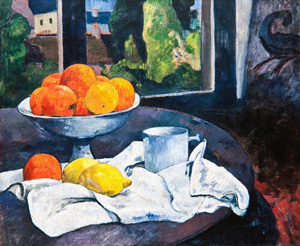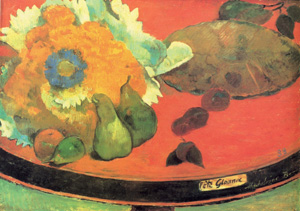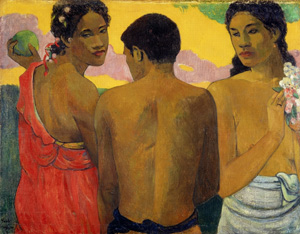Expo is a lot more than just pretty petals
By Eva Tang Specially made for Expo The opening show, ‘The First Lily’, tells a story handed down from generation to generation in one of Taiwan’s indigenous tribes, the Rukai. Viewers are carried into a legend which revolves around the Great Ghost Lake, duels between hawks and serpents, and a cross-species love story between a member of the human race and a serpent. The 40-minute show is a collaboration between the Ping Fong Acting Troupe and the Formosa Aboriginal Song and Dance Troupe. The former is known for its talent for addressing current issues in contemporary society on stage, while the latter works at presenting tribal music and dance which is rooted in indigenous culture. “The First Lily” is the first time these two troupes have worked together on the Rukai legend which circulates through the tribe by word of mouth, rather than in written form. During the show, the hydraulic stage made it possible to present the Great Ghost Lake, which serves as a spotlight among the dramatic narrative and traditional Rukai wedding rituals shown during the performance. The First Lily shows in three sessions a day at Expo Hall from now through January 4, 2011. Altogether they will perform almost 200 shows, and the stage continues with “Blossoms in Wonderland” developed by Diabolo Dance Theatre and Taiwanese illustrator Jimmy Liao. Based on Liao’s work,” Blossoms in Wonderland” is Diabolo Dance Theatre’s first drama work. The troupe is known for introducing diabolo (a two-headed top spun with a cord) into dance acts. In addition, a newly-developed LED diabolo will be used in the show, noted Liu in a press release. “Blossoms in Wonderland” will show from January 7 to March 18, 2011. After these two visually-rich performances, the Expo Hall welcomes U Theatre’s “Flower Petals on the Water” from March 20 to April 25, 2011. U Theatre’s drumming is known to bring viewers peace of mind as elements of Zen and Tao are everywhere in their show. The troupe has held sway on the international stage for years. “Flower Petals on the Water” is a salute to nature, a theme U Theatre knows too well, as its performers have been living and training in the mountains for many years. The story starts off with an exhausted passerby who spends a night in a temple on the mountain. The next day he wakes up after a good night sleep. He steps out of the temple and discovers a flower blooming under the sun. The group resides in the mountainous Muzha area of Taipei. Artistic director Liu Ruo-yu and music director as well as drummer master Huang Chih-Chun train their fellow U people in meditation and the martial arts to help them integrate their minds and bodies. Viewers always find U Theatre’s performances soothing when they are brought into the wonderland of drum. Gigantic caterpillars On to another Expo venue, the Daijia Riverside Park, where visitors can hardly miss a giant insect-shaped canopy which offers 1200 seats for visitors to enjoy a wide range of performances from folk art and belly dancing to acrobatics and flamenco. It aims at entertaining the general public of all ages. Inside the canopy is a medium sized caterpillar, at least in comparison with the super sized one sitting outside the canopy. They are Paper Windmill Theatre’s work, designed especially for parents who take their children to the Expo. The super sized caterpillar is 4.5 meters tall and 40 meters long. It parades around everyday at 3 p.m., enticing visitors to quickly use up the batteries in their digital cameras. Seven rainbow-colored spheroids make up the caterpillar’s body. Each represents one stage in a caterpillar’s life. Global warming and environmental care are the overall message. The steel-structured caterpillars use mostly eco-friendly materials in their decorations and are energized by electricity, thus they produce less carbon dioxide emissions. The figures took the Theatre about ten months to design and produce and cost almost NT$20 million. The medium sizde caterpillar is 30 meters long, and presents classical art works in an interactive way. Visitors can have fun with Jean-François Millet’s “The Gleaners” and Leonardo da Vinci’s “Mona Lisa”. The Dajia Riverside Park lies alongside the Keelung River, and this is reportedly the world's first expo with a riverbank entry. Looking at events taking place at Xinsheng Park, be prepared for an upcoming show from February 14 to 20. French street pianist Jean-Louis Cortès will perform with his legendary Macadam piano. It is a visual and musical performance which is equally at home in streets and market squares, alleyways, parks, cities, villages, festivals, riversides and fields, according to the artist’s website. Meet Gauguin ‘Elsewhere’ at the Expo Besides the French post-Impressionist’s works, 28 creations from schools which are deemed to be inspired or influenced by him, such as Brittany’s Pont-Aven School and the Nabis, will also be shown in the exhibition. As the curator, the Taipei Fine Arts Museum thinks visitors can learn more about Gauguin through his followers. Thus visitors can also appreciate the works of artists including Paul Sérusier, Émile Bernard, Édouard Vuillard and Maurice Denis. Born in Paris, Gauguin spent four years in Lima, Peru, when he was only three years old. The imagery of Peru later influenced his art. Gauguin was a financially successful stockbroker and self-taught amateur artist when he began collecting works by the Impressionists in the 1870s. When the stock market in France collapsed in 1882, he went on to pursue art full-time. In 1891 Gauguin left France to get away from urban civilization. He arrived in Tahiti in French Polynesia and painted his famous Tahiti series there, including ‘Fatata te Miti’ (By the sea) and 'la Orana Maria’ (Ave Maria). In ‘Elsewhere’, viewers can see ‘Three Tahitians’ (1899). Gauguin is considered the first artist to have gained public success in ‘primitivism’, an art movement in the late 19th century. It shows an emphasis on body proportions, animal totems, geometric designs and stark contrasts. In getting away from urban-style life and seeking out a simple one in nature, Gauguin was a pioneer ahead of his time.
Staff ReporterBesides all the must-see plants such as orchids, peonies, calla lilies and the like, the Taipei International Flora Exposition also touts a wide selection of cultural events for expo-goers to enjoy. Ranging from Taiwanese opera to classical ballet to drumming and melodrama on stage, a total of nearly 7,000 cultural events are scheduled to show during the 6-month run of Expo.
Wei Ying-chuan, founder and director of Shakespeare’s Wild Sisters Group, wrote the play, adapting the main characters from Liao’s illustrations while collaborating with the diabolo performers to create a unique show for the Expo. The dancers are required to talk on stage, something they are not used to. According to Liu Le-chun, artistic director for the Diabolo Dance Theatre, the dancers have been preparing the show for a year and a half.
 Next to the Fine Arts Park, the Taipei Fine Arts Museum is showing ‘Elsewhere: Paul Gauguin’ from November 27, 2010, to February 20, 2011. A total of 58 works including oil paintings, engravings, woodcuts, copper sculptures, ceramics and paper art on loan from more than ten museums, foundations or individual collectors in the US, Europe and Japan will be on display.
Next to the Fine Arts Park, the Taipei Fine Arts Museum is showing ‘Elsewhere: Paul Gauguin’ from November 27, 2010, to February 20, 2011. A total of 58 works including oil paintings, engravings, woodcuts, copper sculptures, ceramics and paper art on loan from more than ten museums, foundations or individual collectors in the US, Europe and Japan will be on display. These artists are said to have been influenced by Gauguin during the time he traveled to Bretagne in the northwest of France, and created ‘Conversation in the meadows. Pont - Aven’(1888), ‘Fête Gloanec’(1888) and’ Still Life with Quimper Pitcher’ (1889), which are all being shown in ‘Elsewhere’.
These artists are said to have been influenced by Gauguin during the time he traveled to Bretagne in the northwest of France, and created ‘Conversation in the meadows. Pont - Aven’(1888), ‘Fête Gloanec’(1888) and’ Still Life with Quimper Pitcher’ (1889), which are all being shown in ‘Elsewhere’. The artist took inspiration from primitive subjects and indigenous peoples he found in Tahiti. The tropical colors and simplicity in composition found in his paintings revealed the strong vitality of the South Seas Islands.
The artist took inspiration from primitive subjects and indigenous peoples he found in Tahiti. The tropical colors and simplicity in composition found in his paintings revealed the strong vitality of the South Seas Islands.

![Taiwan.gov.tw [ open a new window]](/images/egov.png)
